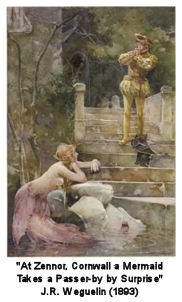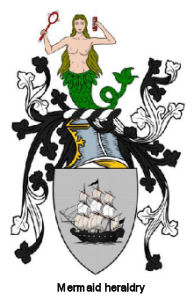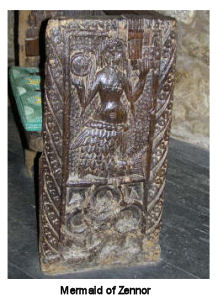|

The Mermaid of Zennor
© 2007 Jay D'Ambrosio, M.A.
and used with permission
Many waters cannot quench love, neither can floods drown it.
— Song of Songs 8:7
 The Cornish village of Zennor, which lies on the southern coast of Britain, is home to a little known legend, a legend that hides a golden kernel of wisdom. If we examine the symbols and imagery woven into this tale, a deeper and more meaningful message can be embraced. It is important to understand that the sea was mother to the sleepy little town of Zennor, as fishermen and sailors comprised the bulk of its tiny population. Mathew Trewella, a young man from Zennor, sang in the choir at St. Senara's church, with a voice that was as silvery as the moonlight, but as powerful as the ocean's tides. The Cornish village of Zennor, which lies on the southern coast of Britain, is home to a little known legend, a legend that hides a golden kernel of wisdom. If we examine the symbols and imagery woven into this tale, a deeper and more meaningful message can be embraced. It is important to understand that the sea was mother to the sleepy little town of Zennor, as fishermen and sailors comprised the bulk of its tiny population. Mathew Trewella, a young man from Zennor, sang in the choir at St. Senara's church, with a voice that was as silvery as the moonlight, but as powerful as the ocean's tides.
His song echoed through the town and across the open sea, mesmerizing all who heard it. One day, a lovely young woman, a mermaid from Pendour Cove, paid a visit to the church to hear Mathew's beautiful voice. Her name was Morveren and she donned a long dress to hide her icthyian tail. She came day after day to listen to the young man, and then would quietly slip back into the sea.
 One day, Mathew's eyes met the charming gaze of Morveren and the two immediately felt an overwhelming love for each other. Knowing she must return to the sea, Morveren tried to slip away, but Mathew caught up to her, wanting to know who she was and from whence she had come. She confided that she was from the sea, a denizen of the deep. He pledged his love for her, and followed her into the waters. Neither was seen again in Zennor, although the townsfolk could often hear his celestial voice being carried aloft by the waves crashing upon the shore. One day, Mathew's eyes met the charming gaze of Morveren and the two immediately felt an overwhelming love for each other. Knowing she must return to the sea, Morveren tried to slip away, but Mathew caught up to her, wanting to know who she was and from whence she had come. She confided that she was from the sea, a denizen of the deep. He pledged his love for her, and followed her into the waters. Neither was seen again in Zennor, although the townsfolk could often hear his celestial voice being carried aloft by the waves crashing upon the shore.
Sometime later, the crew of a ship spotted a beautiful mermaid swimming near their vessel, which was anchored off the coast. The captain recognized the mermaid as the mysterious woman who had frequented the church all those years ago. She requested that the captain raise the anchor as it was blocking the entrance to the grotto that was her home. He obliged and she disappeared beneath the waves, never to be seen again.
If we sift this legend with the pan of medieval symbolism, we can delve into its true meaning and reveal a critical message for modern ears. The azure blue of the sea which made up the greater part of their world was the heraldic color that represented Truth, the truth of God. Truth is what is real about the world, regardless of opinion, place, or time. God is Truth.
The church in medieval symbolism means Revelation, the divine revelation of God. While the sea represents the truth of God revealed in the natural world, the church symbolized the truth of God revealed to mankind. But truth without context is dry. Dogma, theology, and repetition encode and categorize truth. It may feed the intellect, but it can leave the heart longing for more.
 That is the critical moment when the mermaid steps into the tale. In European heraldry, the image of the mermaid denotes Eloquence. The concept of eloquence was cultivated by the ancient Greeks, to whom Calliope was the muse of eloquence, of epic poetry. Eloquence is the story which breathes life into truth. The eloquence which was spawned by the truth, the sea, enters the church, the seat of divine revelation to humanity. The eyes, the windows of the soul, meet and truth is forever united with eloquence, the story that brings truth to life. That is the critical moment when the mermaid steps into the tale. In European heraldry, the image of the mermaid denotes Eloquence. The concept of eloquence was cultivated by the ancient Greeks, to whom Calliope was the muse of eloquence, of epic poetry. Eloquence is the story which breathes life into truth. The eloquence which was spawned by the truth, the sea, enters the church, the seat of divine revelation to humanity. The eyes, the windows of the soul, meet and truth is forever united with eloquence, the story that brings truth to life.
Story is the way in which the heart understands truth. Truth alone doesn't feed us, it doesn't inspire. The epic is the context into which the truth can be properly placed. That is why some find the concept of God distant and difficult to relate to, whereas the story of God in Christ who ate, drank, laughed, and bled like one of us romances the soul.
Mathew embraces the creature of the sea, the poetry of the sea, and disappears from the world of those who live lives of dry and quiet desperation. His song remains, though, forever stirring the hearts of those who would hear the eloquence of truth, not simply its repetition.
As if to further churn the deep meaning of this tale, the legend goes on to say that the mermaid is again spotted years later near the coast of Zennor. The ship, from which she is spotted, is not without significance, as ships on lordly crests symbolized the ancient sea voyages of noble ancestors. "Look back!" the ship reminds us. Do not forget the story. The mermaid asks the captain to move the ship's anchor as it blocks the way into her watery home. The anchor can represent dogmatic religion. A ship is meant to journey on the sea. Yes, an anchor is sometimes very important as it prevents a ship from being blown about by storms, but a ship that is anchored too long can become stained with seaweed and encrusted in barnacles. Likewise, a heart that is bound by the religious motions that often neglect the divine Story can become coated and stained. Yes, an anchor is sometimes very important as it prevents a ship from being blown about by storms, but a ship that is anchored too long can become stained with seaweed and encrusted in barnacles. Likewise, a heart that is bound by the religious motions that often neglect the divine Story can become coated and stained.
The anchor impedes the mermaid from entering into the grotto, the heart of the sea. It stops eloquence from entering into the heart of truth. The captain does eventually raise the anchor, allowing the mermaid to return home. In the end, Mathew and Morveren are united in Love. Ultimately we too need to seek unity between Truth and the Story that captivates our hearts. If one visits Zennor today, the mermaid can still be seen in a five hundred year old image carved into the side of a pew in St. Senara's church.
Read the story of the Mermaid of Zennor
Jay D'Ambrosio, M.A. is an ancient history teacher and the author of Rethinking Adolescence: Using Story to Navigate Life's Uncharted Years (Rowman & Littlefield Education, 2006), as well as "Egyptian Influence on Early Israelite Literature" (Aeon: A Journal of Myth, Science, and Ancient History, 2005). You can learn more about this topic by visiting Jay's blog at http://eteaching101.blogspot.com. (Rowman & Littlefield Education, 2006), as well as "Egyptian Influence on Early Israelite Literature" (Aeon: A Journal of Myth, Science, and Ancient History, 2005). You can learn more about this topic by visiting Jay's blog at http://eteaching101.blogspot.com.
Read more articles in Mythic Passages by Jay D'Ambrosio
Return to Mythic Passages Menu
Subscribe to the Mythic Passages e-magazine
|

